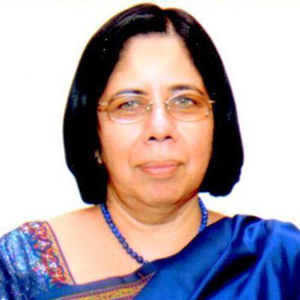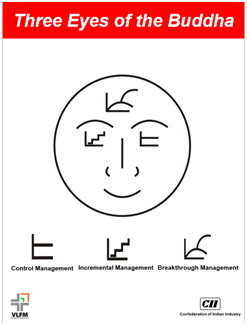Make in India to Make India-Dr.Sarita
- Home
- >
- About us
- >
- What do Leaders Say
- >
- Make in India to Make India-Dr.Sarita

If you have to pick one field within the Indian automotive domain which can drastically change its landscape, what would it be? Had I been asked this question before the pandemic; I would have had multiple answers to it. But, looking at the global shifts, I strongly concur with our guest's championship towards the below ideology.
"Make in India to make India."
Having worked in the manufacturing vertical for 30+ years, Dr.Sarita Nagpal, former CII, gladly shares the mindset, skills, and resources needed to create breakthroughs in this transforming field. Her love for teaching, co-creator attitude, and passion for work will make you want to emulate her successful journey.
I hope you enjoy and learn from my conversation with Dr.Sarita as much as I did.
Story from the beginning:
Back in Oct. 1989, Dr.Sarita started with CII as a Quality Engineer under their newly established Total Quality Management (TQM) Division. 'Call to join the Quality Movement' read the advertisement post she had responded to. Coming from the background of electrical engineering, she was not sure whether the job was the right fit for her. However, her parents inspired her to grasp the opportunity that life has thrown at her;thus,she began her quality journey. Working from the time when quality was limited to standard compliance and statistical quality controlto recent advances such as No Fault Forward quality control, I was curious to ask her views on the modern-day quality.
I hardly knew that I was in for a big treat for asking this question. Back in the days, her team's focus was on ISO 9000 certification and Total Quality Management/ Total Productive Maintenance (TQM/ TPM) adaptation. With the advancement in the quality and manufacturing sector, she suggested that the contemporary leader can evolve by focusing on compliance, continuous improvement, and transformation. India needs to take a leap and set the benchmark by consolidating present capabilities and strengthening leadership at all levels.Being a dedicated teacher, she went on to explain one of the principles from the coveted 'Visionary Leaders of Manufacturing' (VLFM) Program.' The principle '3 eye buddha' focuses on the following three aspects, which would transform the quality leader and thus, their organization.
 1. Eye for Control- Maintaining the standard and abiding by customer and supplier requirements,
1. Eye for Control- Maintaining the standard and abiding by customer and supplier requirements,
2. Eye for Continuous Improvement- Adding value by focusing on continuous improvement; it also helps in better alignment with changing technology and customer needs,
3. Eye for break-through-Building conceptual skills and capabilities to create future business.
She said that contemporary leaders must focus on the 3rd eye to counteract the decline of an existing business. To maintain the balance, the leaders should guide their teams to take up the first two eyes of the Buddha.
Highlights from the current position:
I was enlightened with this concept and thought how much it could help an individual in their professional life irrespective of their current position. My curiosity took the better part of me, and I switched from a pre-prepared questionnaire to asking more about VLFM and similar programs. Who better to answer it than the senior technical advisor of the program? Since its inception, Dr.Sarita had played multiple roles that of a faculty, curator, marketer, and networker. Listening to her, I thought to myself that only when a person is passionate about bringing manufacturing revolution can they put the success of Indian companies first, even post her superannuation in 2012. She went on to attribute her success and that of the VLFM project to the success of industries.
In the brief time I had spent with her, she shared about the senior managers and the 1000 Visionary Small and Medium Enterprises (VSME) courses from the program. In her words, it is a journey of Good to Great. For instance, the VSME program focuses on the alignment of:
a. OEM/Tier 1 with the market,
b. Multiple Tier 2/ Tier 3 suppliers with OEM/Tier 1.
In simple words, if you go pick a product in the market, this will then generate a lead for the purchasing members who, will share the order with the production team to initiate the manufacturing. It will lead to the highest efficiency and zero waste. But, when you have multiple suppliers and tight inventory for each, how can you wait for the market response? The VSME program unravels the salient features needed to resolve this mystery and has helped 1211 companies so far.
The senior manager's course dives into the five-step discovery of learning conceptual skills. From the five shared to me, my personal favourite step was to jump into the fishbowl. It is the observational skill where one gets into the environment and perceives something invisible to most eyes. Over the last 13+ years, the program has seen 700+ cross-functional leaders who are now focused on transforming the Indian way of manufacturing management in close to 300+ companies.
Dr.Sarita sees the manufacturing sector as a playground for Indian youth to contribute, and in turn, grow their skills and competencies. It is the key to self-reliance where you can leverage Indian minds, Indian resources, and Indian customers. She shares the examples of government initiatives and many leaders such as Mr. Ratan Tata, Mr. Anand Mahindra, Mr.Venu Srinivasan, Mr.Pawan Munjal, Mr. John Edwin, Mr. Sunjay Kapoor who are striving to create more opportunities for youth to engage in science and technology, and specifically, manufacturing.
Undoubtedly, her final message is to join the manufacturing community!
Brief Write-up Author – Riya, Functional Safety Manager at Mahindra Electric Mobility Limited, is an environmentalist at heart, reader by choice, and writer by passion.


